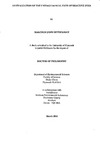An evaluation of the environmental fate of reactive dyes
| dc.contributor.author | Hetheridge, Malcolm John | |
| dc.contributor.other | Faculty of Science and Engineering | en_US |
| dc.date.accessioned | 2011-05-13T11:53:06Z | |
| dc.date.available | 2011-05-13T11:53:06Z | |
| dc.date.issued | 2001 | |
| dc.identifier | Not available | en_US |
| dc.identifier.uri | http://hdl.handle.net/10026.1/467 | |
| dc.description | Merged with duplicate record 10026.1/697 on 01.02.2017 by CS (TIS) | |
| dc.description.abstract |
Dyestuffs are widely used industrial chemicals, yet surprisingly little is known about their fate in the environment. The potential modes of transformation and removal of reactive dyes in treatment and in the environment are principally through anaerobic and aerobic biodegradation and photodegradation. The research herein describes the use of LC-MS analysis with laboratory simulations to develop a better understanding of the occurrence and fate of reactive dyes and their degradation products in the aquatic environment. One reason for the lack of information on the environmental fate of reactive dyes has been the paucity of robust analytical methods suitable for the determination of dyes in aqueous samples. Robust analytical methods were optimised to provide LC-MS and MSMS identification of degradation products. Additionally, interpretation of the MSMS spectra of known reactive dyes provided novel characteristic fragment ions indicative of the triazine reactive group of reactive dyes . Fibre reactive dyes are designed to have a degree of photostability and therefore their photodegradation behaviour has not been widely investigated. Little is known of their stability to daylight over prolonged periods of irradiation in dilute aqueous solutions and in the presence of humic substances. The kinetics of photodegradation of an anthraquinone dye (Reactive Blue H4R) and azo dye (Reactive Yellow P5G) were evaluated. The former underwent rapid and extensive degradation 01/2 1.5 h). The major products formed were identified using LC-MSMS and a photodegradation pathway proposed. By comparison, the photodegradation of the azo dye was significantly slower, 01/2 30 h). The addition of humic substancesa ppearedt o have little effect on the rate of photodegradationu nder the conditions used. The reduction of azo dyes under anaerobic treatment has been extensively studied, but the subsequent fate of the initial reduction products when exposed to air are not understood. Three relatively simple azo dyes, Amaranth, Sunset Yellow and Naphthol Blue-Black, were reduced and their autoxidation products identified by LC-MS. These were subsequently used to predict the autoxidation products of a more complex azo reactive dye: Reactive Red 3.1. Additionally, a persistent degradation product from the anaerobicaerobic treatment of Reactive Red 3.1 was identified from LC-MS data. Azo reactive dyes are generally regarded as being resistant to aerobic degradation and there are few published data regarding degradation pathways for reactive anthraquinone dyes. Pure cultures of Pseudomonas docunhae, A 9046 and A texaco and mixed bacterial consortia (semi-continuous activated sludge, SCAS) aerobic degradation of azo and anthraquinone reactive dyes was studied. Two azo dyes were degraded by pure cultures of A docunhae and A 9046, suggesting that azo dyes can be aerobically degraded given favourable conditions. The antraquinone dye was extensively degraded by SCAS and pure culture biodegradation. Metabolites were identified by LC-MS and a degradation pathway proposed. | en_US |
| dc.description.sponsorship | AstraZeneca Brixharn Environmental Laboratory Freshwater Quarry Brixharn, Devon | en_US |
| dc.language.iso | en | en_US |
| dc.publisher | University of Plymouth | en_US |
| dc.subject | Aquatic Environment, Chemistry of | |
| dc.subject | Organic Water Pollution | |
| dc.subject | Water Pollution | |
| dc.subject | Sewage | |
| dc.subject | Biomedical Engineering | |
| dc.subject | Biochemical Engineering | |
| dc.subject | Aquatic Environment | en_US |
| dc.title | An evaluation of the environmental fate of reactive dyes | en_US |
| dc.type | Thesis | |
| dc.identifier.doi | http://dx.doi.org/10.24382/4365 |
Files in this item
This item appears in the following Collection(s)
-
01 Research Theses Main Collection
Research Theses Main


